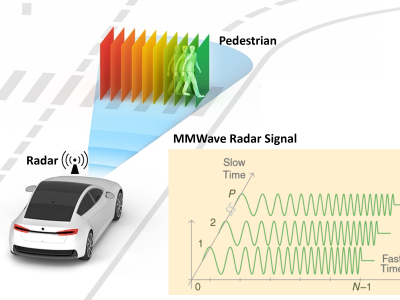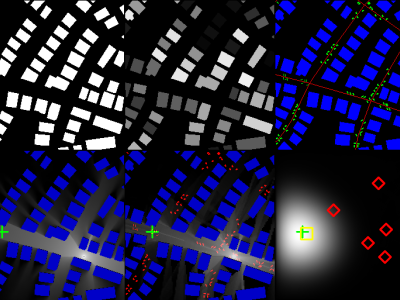CRAWDAD cister/rssi

- Citation Author(s):
-
Claro NodaShashi PrabhMário AlvesThiemo VoigtCarlo Alberto Boano
- Submitted by:
- CRAWDAD Team
- Last updated:
- DOI:
- 10.15783/C7WC75
 155 views
155 views
- Categories:
Abstract
Channel energy levels from Wi-Fi networks as seen from a 802.15.4 radio.
We use a sensor network composed of TelosB motes deployed in the library building to collect RF energy level samples (RSSI) on all 802.15.4 channels in the 2.4 GHz ISM Band. The building has several collocated Wi-Fi networks in normal operation. These networks produce interference for the 802.15.4 radios. Sensor nodes record RSSI values every 20 us, simultaneously on all channels, for 130 ms and then write the result to the respective files. This process is repeated every 8 seconds for around 4h.
date/time of measurement start: 2010-11-25
date/time of measurement end: 2010-11-25
collection environment: The data was collected in the library of the Faculty of Engineering at the University of Porto, Portugal. Over 300 MAC addresses were registered in the Wi-Fi networks during the measurement as indicated by complementary Kismet traces, not included in this set.
network configuration: The network consisted of 17 TelosB nodes connected to a laptop PC via USB. One node acted as master and broadcast scan commands on channel 26. Other nodes scanned one 802.15.4 channel (2.4 GHz) each for 130 ms at a time. Collocated 802.11b/g APs provide connectivity to library users with portable computing devices.
data collection methodology: All 16 nodes scan RSSI values (with the CC2420 radio chip on-board) at 20 us resolution, as the local memory permits, and then write to an associated data file (one per channel/node) on the laptop HDD.
limitation: Serial communication on the TelosB motes is remarkably slower than the rate at which it is possible to read RSSI via the CC2420 radio in the TelosB platform. Therefore, traces contain 130 ms of RSSI data every 8 seconds, to allow sufficient time for the nodes to complete the data dump process.
error :Two nodes apparently had misbehaving radios, which captured wrong RSSI values. They were originally intended to scan channels 7 and 13. This was detected beforehand and two other (well behaved) nodes were added to replace the data from the former ones (19 nodes, all in all). Original (wrong) traces are also included as a curiosity.
sanitization: The data does not contain any sensitive information that could raise any privacy concerns. Therefore, no sanitization is performed.
Traceset
802.15.4
Channel energy levels from Wi-Fi networks as seen from a 802.15.4 radio.
- file: 15.4_RSSI.zip
- description: We use a sensor network composed of TelosB motes deployed in the library building to collect RF energy level samples (RSSI) on all 802.15.4 channels in the 2.4 GHz ISM Band. The building has several collocated Wi-Fi networks in normal operation. These networks produce interference for the 802.15.4 radios. Sensor nodes record RSSI values every 20 us, simultaneously on all channels, for 130 ms and then write the result to the respective files. This process is repeated every 8 seconds for around 4h.
- measurement purpose: Bit Error Characterization, MAC Protocol Development, Usage Characterization, Energy-efficient Wireless Network, Opportunistic Connectivity
- methodology: All 16 nodes record RSSI values (with the CC2420 radio chip on-board) at 20 us resolution, as the local memory permits, and then write to an associated data file (one per channel/node) on the laptop HDD. All nodes are time synchronized, via scan commands sent by master node on ch 26.
802.15.4 Trace
- 2010: Channel energy levels from Wi-Fi networks as seen from a 802.15.4 radio.
- configuration: 16 nodes were scanning on one 802.15.4 channel each, and one more node was working as the master node to synchronize the network, by sending a scan command on channel 26. Sensor nodes were positioned close to each other on the 2nd floor of the 4 level building and wired to a nearby (2-3 m away) laptop computer via USB. A Contiki OS script performed data collection on the nodes.
- format: Consecutive RSSI values are recorded in separate files, one file for each channel/node. Each file has a header, containing the id and the channel of the node. Each 130 ms capture contains a header, which specifies scan beacon and sequence number. These two values do not always match, as the scanner node occasionally misses the scan beacon from the master, e.g. due to interference. To avoid repetitively using the minus sign in all values in the files, we use an implicit offset. In order to convert these values to dBm, please subtract 100, e.g., 44 in the file corresponds to -56 dBm.
Instructions:
The files in this directory are a CRAWDAD dataset hosted by IEEE DataPort.
About CRAWDAD: the Community Resource for Archiving Wireless Data At Dartmouth is a data resource for the research community interested in wireless networks and mobile computing.
CRAWDAD was founded at Dartmouth College in 2004, led by Tristan Henderson, David Kotz, and Chris McDonald. CRAWDAD datasets are hosted by IEEE DataPort as of November 2022.
Note: Please use the Data in an ethical and responsible way with the aim of doing no harm to any person or entity for the benefit of society at large. Please respect the privacy of any human subjects whose wireless-network activity is captured by the Data and comply with all applicable laws, including without limitation such applicable laws pertaining to the protection of personal information, security of data, and data breaches. Please do not apply, adapt or develop algorithms for the extraction of the true identity of users and other information of a personal nature, which might constitute personally identifiable information or protected health information under any such applicable laws. Do not publish or otherwise disclose to any other person or entity any information that constitutes personally identifiable information or protected health information under any such applicable laws derived from the Data through manual or automated techniques.
Please acknowledge the source of the Data in any publications or presentations reporting use of this Data.
Citation:
Claro Noda, Shashi Prabh, Mário Alves, Thiemo Voigt, Carlo Alberto Boano, cister/rssi, https://doi.org/10.15783/C7WC75 , Date: 20120517
















